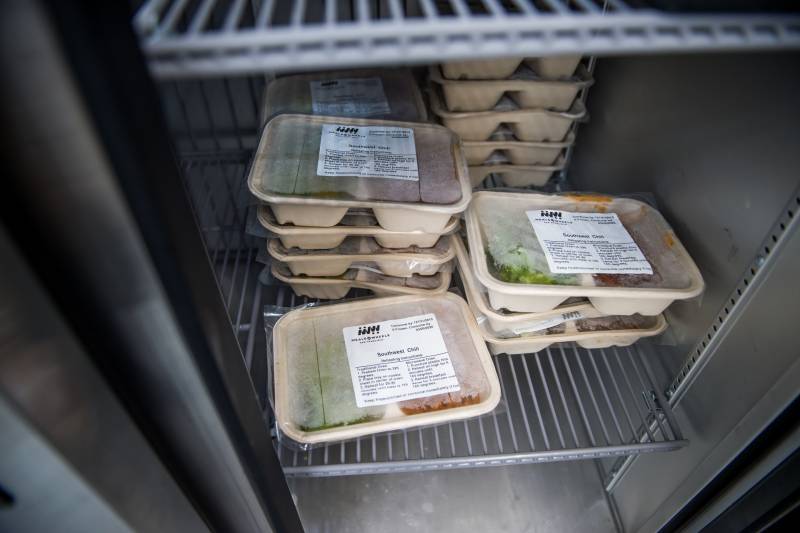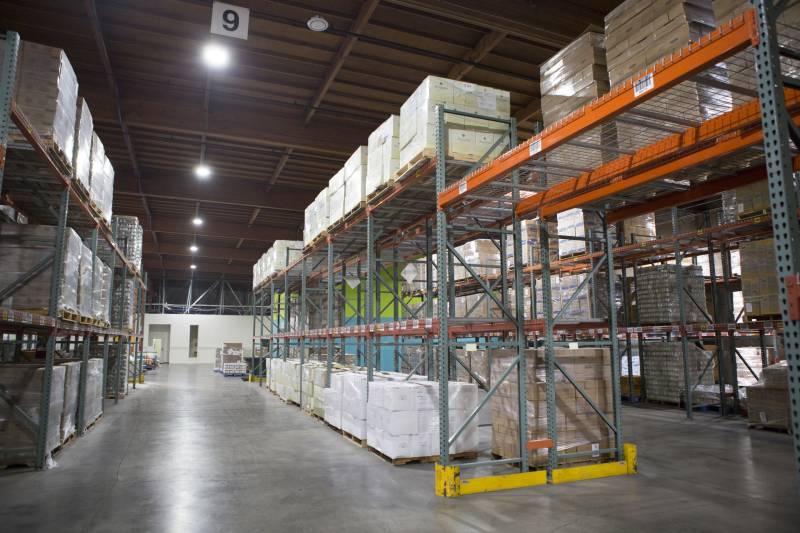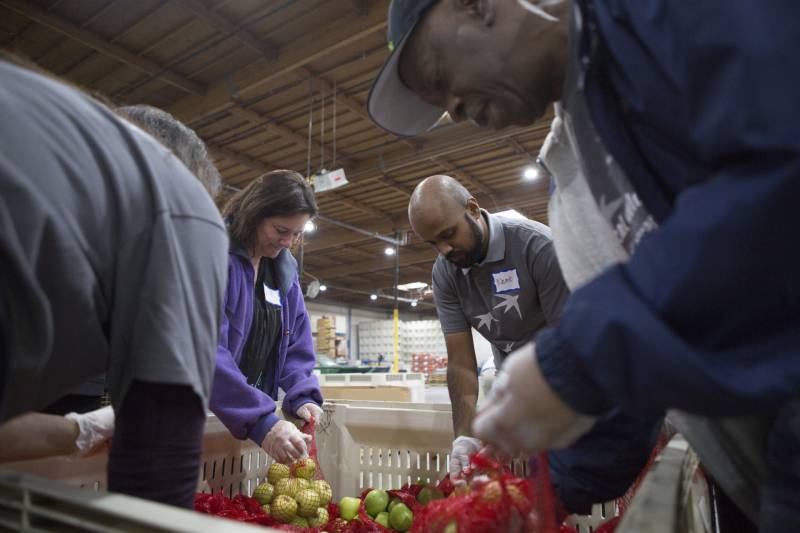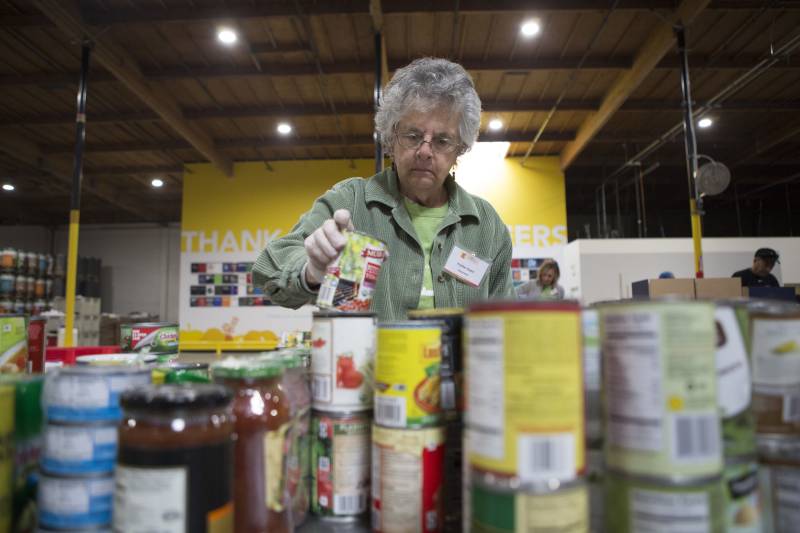At the beginning of the pandemic, food banks were hit with two simultaneous surges: one, of need, as the economy got thrown into chaos, and two, of generosity, as millions found themselves suddenly out of work. Others who found themselves in fortunate circumstances gave money and donations to food banks.
While the need has remained elevated, the generosity has trailed off, pushed out of mind by everything else going on in the world. According to the hunger-relief organization Feeding America, in 2020 food banks nationwide distributed 6 billion meals, and 4 out of 10 people visiting food banks were there for the first time. As a result of the pandemic, an estimated 42 million people faced hunger nationwide in 2021. With the cost of food rising, it all adds up to a frightening outlook for our region's food assistance organizations.
KQED Forum's Alexis Madrigal hosted a discussion on food insecurity and hunger in the Bay Area and about the outlook for 2023. Guests included:
- Regi Young, executive director of the Alameda County Community Food Bank
- Jim Oswald, director of marketing and communications with Meals on Wheels, San Francisco
- Dana Cronin, longtime hunger and food insecurity reporter
This interview has been edited for brevity and clarity.
Alexis Madrigal: What are the current trends right now that are really impacting food banks, not just here but across the country?
Regi Young: I would say that for food banks across the country, we are seeing a lot of similar challenges. For the most part, high inflation is making food costs a lot higher for food banks no matter where you're at within the country. But along with that, we're still seeing record needs since the pandemic.
In fact, I would say that for a lot of food banks, what I'm hearing is that the need at the height of the pandemic is equal to what we are experiencing right now. And so the challenge of ensuring that everybody has a meal so that people are not going hungry within our community is even more challenging for food banks and their network of partners that they work with.
And on the donation side of it, the big Silicon Valley food bank [Second Harvest] has seen donations fall by almost 40% since the height of the pandemic two years ago. Is that same thing happening in other food banks, and is it indicative of a wider trend?
Regi Young: Yeah, I would say that's pretty consistent for us. Our costs have increased probably double from prior to the pandemic. But we are anticipating that we're going to see an 11% decrease in funding this fiscal year for us. And so it is a challenge, because we are not seeing the changes in need within our community. We're not seeing the changes in the number of people that are coming to the pantries and wanting food and the long lines that are present there. And so for us, it is critically important that we are still able to serve at the same rate that we were doing a year ago or two years ago. And the resources are not the same.

Let's talk about the price of food right now, to give people a sense of the kind of the systemic problems that have been leading to this rise in the cost of staples, like eggs and chicken.
Dana Cronin: I think it's almost impossible to go to the grocery store right now and not notice the sky-high food prices. There are a couple of things at play here. One is that we are in a global food crisis right now, and there are a couple of contributing factors there like climate change and the ongoing war in Ukraine. These have impacted some of our staple crops.
You know, last summer we saw really intense heat waves in Europe. We saw drought in China. We saw extensive flooding in Pakistan that has impacted staple crops like rice and corn, for example. As for the war in Ukraine, it has significantly impacted the global wheat supply because Ukraine and Russia are both global exporters of wheat. One economist I talked to likened this conflict to a war between Saudi Arabia and Iran and how that would likely lead to an oil crisis, while in this case it's led to a wheat crisis. But at the same time, food companies have taken advantage of this moment and of this opportunity and are raising their prices even higher.
So companies like Tyson, General Mills and Cargill are seeing record profits even amid all of these staple crop shortages. I talked to an economist, William Spriggs, who said this is kind of like price gouging. He compared it to going to Florida after a hurricane and selling bottled water for $20 a bottle. If you did that, you would get arrested because that is illegal. But we just don't have the legal infrastructure in place to handle price gouging at such a massive scale.
How do these rising food prices weigh on individual people who are trying to make ends meet?
Dana Cronin: I just want to start out by saying that I am so grateful to the folks that I've talked to for my stories. I know it's an incredibly delicate issue. In my most recent piece that I wrote for Civil Eats, I spoke with a woman named Gilmer Dominguez who is a single mom living in LA with her son JP, who is on the autism spectrum and who has a really strict diet and isn't as flexible as others in terms of being able to substitute cheaper foods into his diet.
She receives monthly allotments through SNAP, the Supplemental Nutrition Assistance Program, otherwise known as food stamps. She is a refugee from El Salvador. She came here in the last few years seeking refuge. I spoke with her just a few weeks ago on the phone, and she receives about $400 or so a month through SNAP. But she just told me that it's simply not enough for her and her son.
She told me a story about standing in line at the grocery store and watching as the cashier beeped each item that she was buying. And the total just kept rising and rising and rising. And she ended up just having a panic attack there in the grocery store line because of how overwhelming that experience is where she's just not used to seeing prices so high and her SNAP dollars don't go as far as they once did. She told me her SNAP allotment used to cover almost three weeks of groceries. It's intended to cover the month, but it used to cover about three weeks. Now it barely covers two. So she's really struggling to make ends meet. And I've talked to others who are in similar situations.
Have you seen any changes in the different types of people who are availing themselves of these services at the Alameda County Community Food Bank since the pandemic hit?
Regi Young: Absolutely. So the challenge of food insecurity was already a major issue prior to the pandemic. But what we ended up seeing was a large number of new recipients, first-time users of a food pantry or a food bank. That number began to rise dramatically during the pandemic and is still the case right now. We have a call center at the food bank, and about 30% of the callers calling for some form of food assistance are first-time users of food assistance. This challenge is already so difficult, and now we're seeing it expanded to a variety of different people that may have never thought they would be here. And these are folks out of work.

Do you think that change is kind of permanent, unless we made an all-out effort to change the situation that existed even pre-pandemic?
Regi Young: I do think there are some long-lasting effects that may be present if costs stay high, particularly for us in the Bay Area. The cost of living is just high in general. And so what we're seeing is a confluence of issues and really a heightened awareness of where to access food, even for those people who may have needed it but did not know where to go prior to the pandemic and prior to all the media coverage on food insecurity. I absolutely think there's a lot of things that we can do to mitigate this issue. In fact, I think that food insecurity could be eradicated in the Bay Area with the right political will and resources, because I feel like the money is there. But yeah, this will be a challenge that we are going to deal with for a long time if there's not some dramatic changes that occur.
I know that there's different ways of calculating food insecurity, but by your best estimates at Alameda County Community Food Bank, how many people do you think are actually experiencing this in Alameda County and in the East Bay?
Regi Young: Our estimate is that there are about 1 in 4 people that are dealing with some form of food insecurity within Alameda County. And this was 1 in 5 prior to the pandemic itself. And so about 25% of the population may need some form of this and may not know where their next meal is coming from.
Can you talk about the number of people aging in place? The pandemic put incredible strain on nursing homes and on other places where our elders live. Maybe more of them have decided to stay at home. What has that done for Meals on Wheels?
Jim Oswald: It truly has increased. Our capacity was overflowing, as Regi said. We saw an increase in need as well at Meals on Wheels in San Francisco. Here's the reality: In San Francisco, by 2030, 30% of the population will be aged 60 and older. Nationwide, 12,000 Americans are turning 60 each day, and many of those seniors will need resources. Just before the pandemic, we were serving roughly 3,500 seniors a day who rely on us for home-delivered meals. That number skyrocketed in the first year of the pandemic, almost by about 200%. And that included partnering with the city and county of San Francisco.
Meals on Wheels, San Francisco ultimately operate in what's called the isolation and quarantine hotline, so anyone of any age who was impacted by COVID called us and, partnering with the SF–Marin Food Bank, we prepared meals and delivered them out to people who could not get out and get food. The reality is these problems have always been there, accessibility and affordability. Many of our seniors, almost 72% of them that receive our meals, live on less than $1,000 a month here in San Francisco, which is really hard to fathom. I spoke with a really charming lady a number of years ago who said that after she pays her bills, her rent and everything, she had exactly maybe $100 left for the entire month.
So imagine trying to purchase and get well-balanced meals that are healthy for you. She literally told me that sometimes she would just drink water to feel full. That's really powerful. We owe it to our communities to support them. And it starts, certainly, with funding. But it's much more than that. It's providing the resources down the line to be able to take care of people as they age in place.



